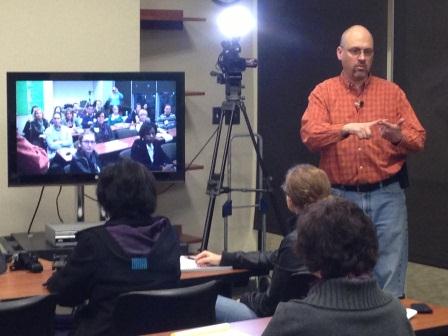Putting the “story” in visual storytelling
WEWS-TV5 trainer offers practical tips in multimedia workshop

Telling stories in a multimedia world requires good lighting, good sound and good visuals. But mostly it requires people who have stories to tell, and communications professionals who can capture those stories, Mike Harris, chief photographer for WEWS-TV/Channel 5, told attendees at the first workshop in The Press Club series “Mastering Multimedia Communications; Reinventing yourself for a cross-platform world.”
Harris, an Emmy-award winning videographer, has spent his career telling visual stories and teaching others how to do so. At Channel 5, he trains reporters and photographers on multimedia journalism techniques, including the latest technology.
On March 6, he brought that knowledge – and several pieces of the technology - to the 18 people at the workshop on “Telling Visual Stories.” The Press Club collaborated with Cleveland State University’s School of Communications to present the series in CSU’s Main Classroom Building. Dr. George Ray, the school’s director, welcomed the group.
The crowd included everyone from students to print professionals to multimedia journalists looking to learn new skills. The workshop followed the successful series kick-off on Feb. 6 at the Market Garden Brewery. Three more workshops are planned. See upcoming workshops here.
Harris acknowledged there is a learning curve for non-MMJs (multi-media journalists) to get comfortable with the new reality. But he was optimistic that participants will become as comfortable using a camera as they were using pencil and paper.
“You have to get past the hurdle of the technical end,” he said “You’re going to miss a lot of stories and screw up a lot of video, but six months down the road, as long as you practice and try not to make the same mistakes, you’ll get there.”
With several cameras on display and passed around the audience, he noted the quality or price of the camera – whether $200 or $10,000 – is secondary to how its used. “It’s all how you produce your video that you can make magical video. Lighting, audio and composition will set you apart from anyone else.”
Above all, he said, focus on the people you report on. “You want to find stories, not Official Number One. We care about people. You want to hear their voices.”
Harris also demonstrated the best ways to use lighting, how to compose a shot for maximum effect when it appears on screen, and how to make transitions effective.
A key to success for journalists transitioning into multi-media is to try different things. Play around with the equipment, he said; learn its intricacies, have fun and learn from mistakes. Even the pros sometimes air less-than-perfect pieces.
“Any idiot can capture something on video,” he said. “It’s your experience as a reporter that’s going to capture the story. You’re going to use your journalism, once out get past the equipment.”